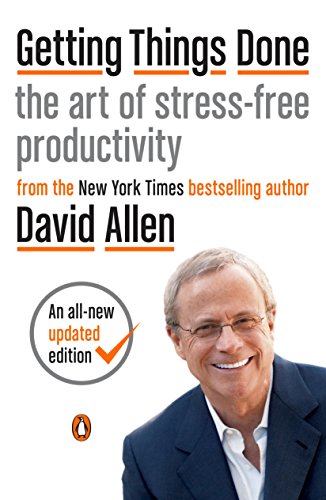

This article is an excerpt from the Shortform summary of "Getting Things Done" by David Allen. Shortform has the world's best summaries of books you should be reading.
Like this article? Sign up for a free trial here .
Are you beginning the Getting Things Done system, and need a great GTD guide?
This GTD guide covers all the basics of the GTD system, as well as why you should be using it. In this GTD guide, you’ll learn what GTD is, why it works, and the benefits of using it.
Your GTD Guide: Why It Works
The Getting Things Done (GTD) program is designed to increase your productivity and effectiveness—not so you can squeeze even more into your already busy life, but so that you can do things with less time, energy, and effort. When you feel in control of your life and your to-do list, you can be present in each moment without the nagging feeling that there’s something else you should be doing. When your mind is clear, you can focus and use your creative energy for the task at hand, and in your free moments, you can fully enjoy life without feeling guilty that you’re not doing something “productive.” This GTD guide shows you how and why to use the GTD program to live organized and stress free.
The GTD program is meant to be a lifelong practice, and you’ll continually graduate to more advanced levels of application. As you start to cement the strategies as habits, you’ll reach new levels of mastery to enhance your life and productivity in new ways: Once staying on top of your emails is second nature, use your skills (and newfound free time and energy) to take on a new hobby or strengthen your important relationships.
In the meantime, don’t wait until you finish the book to start using the strategies—put them into practice as you go. Practicing the skills will give you a richer understanding and help you dive deeper into the program.
Many readers regularly re-read this book and come away with something new each time. The program requires more habit changes than most people can fully implement all at once, so readers tend to absorb pieces at a time; after the first time through, start practicing the basics, and the next time you’ll better understand the strategies for refining those basic skills. Each time you read the book, you gain a new level of understanding and practice.
The Five Steps of the GTD Guide
Through the GTD system, you’ll capture every task and reminder on lists, in files, and on your calendar. You’ll be aware and in control of your entire workload so you can be fully present in each moment without the nagging feeling that you should be doing something else.
The five steps of the GTD system are:
- Capture all the problems and ideas that are taking your attention.
- Clarify what each one means and what you need to do about it.
- Organize the decisions and actions you’ve clarified.
- Reflect on everything in front of you to choose what to tackle next.
- Engage with the task (get it done).
When you first start out, you’ll have a large mental backlog of items to capture and process, and this will take a good amount of time. After you get through it once, you’ll have all the items in the proper place. Then, on a regular basis (for example, daily), you’ll step through the five steps to capture and process new items, then figure out what you want to do that day. This GTD guide can serve as a reference to walk you through the steps.
Use the Natural Planning Method to Plan Projects
Always have a next action identified for each project you have, so that you’re constantly making progress on your projects. Determining next actions on big projects can be daunting, but simply follow the same process you’d use if you were planning something in your daily life, like a birthday dinner with friends. This approach is an important part of the GTD guide.
This approach is called the Natural Planning Method, and it consists of these steps:
- Define your purpose and principles. Your purpose is the intention of the project, and your principles create the boundaries. If you’re planning a birthday dinner, your purpose is to celebrate and the boundaries could be factors like how affordable you want the restaurant to be.
- Envision your outcome. Your purpose is your why, while your outcome is the what: What will a successful outcome look, feel, and sound like? You might imagine your dinner happening around a big outdoor table, with all your friends laughing and sharing food. When you picture something and focus on it, it helps you create it and makes you more excited to achieve it.
- Brainstorm. This is the how. Your brain naturally wants to fill in the gaps to determine how to make your vision a reality. During this stage, you might question whether the restaurant is open today, what time you need to go, and whether there’s gas in the car. Use mind maps or other brainstorming techniques to jot down as many ideas as you can without judging or criticizing the ideas along the way.
- Organize. This is the step when you organize all the random thoughts, questions, and ideas from the brainstorming process. You’ll naturally organize them based on logistics, priorities, and what needs to happen first: Call the restaurant to see if it’s open and make a reservation, then invite the guests, then get yourself dressed and ready to go.
- Determine your next actions. Determine what can actually be done now, and who’s going to do it. For dinner, your next action is to call the restaurant.
Implementing and mastering the GTD system is a lifelong process that helps you manage your day-to-day obligations while keeping your larger goals in mind.
First, master the principles and practices, cement them as habits, and gain control of your daily tasks. Once you reach this point, take a bigger-picture approach to managing and organizing your life; proactively initiate projects to improve areas of your life. Ultimately, you can leverage the GTD system to implement new habits, tackle bucket-list aspirations, and create the lifestyle you want.
Create Checklists
One final recommendation of the GTD guide is checklists. Use checklists in two ways to further keep your mind clear and stress-free.
First, create checklists for broad areas of your life—like maintaining good physical health and keeping motivation and morale up among your team at work—so that you can regularly review and confirm that you’re still attending to that priority.
Checklist items like these often encompass items for your Projects list and Next Actions list (for example, creating an exercise regimen or planning a team-building activity), but as those particular tasks vary use your checklist to ensure you’re staying on top of things in that general area.
Consider creating checklists that pertain to these areas of your life:
- Career goals
- Creative endeavors
- Family
- Finances
- Health and well-being
- Relationships
Second, you can use checklists to help you remember a sequence of steps or the various components of something, the way you would use a recipe. Examples of this include:
- Instructions for fixing a recurring tech problem
- Job duties when you’re new to a position
- All the steps of a new workflow you’re implementing
- Items to pack on every trip you take
- Everything you need to review and update during your Weekly Review
Keep your checklists current and relevant by creating them and tossing them whenever appropriate. (Shortform note: For more on the benefits of checklists and how to create them, read our summary of The Checklist Manifesto here.)
There are many GTD guides out there to help you on your journey to productivity. Use this GTD guide as a jumping-off point to learn even more about the GTD system.

———End of Preview———
Like what you just read? Read the rest of the world's best summary of David Allen's "Getting Things Done" at Shortform .
Here's what you'll find in our full Getting Things Done summary :
- Why you're disorganized and your to-do list is a mess
- The simple workflow you can do everyday to be more productive than ever
- How to take complicated projects and simplify them






